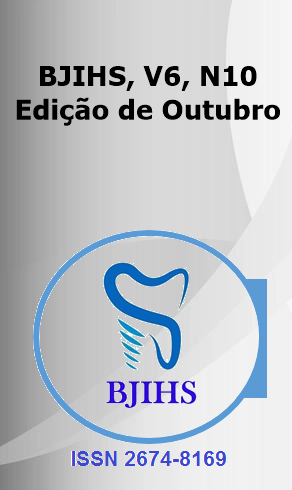Abstract
Introduction: Communication is one of the fundamental pillars of human interactions, allowing for the exchange of information and feelings. However, for deaf individuals, traditional spoken communication is not feasible. In this context, literary works such as “The Awakening of Silence” play a crucial role in raising awareness among the public and security agents about the reality of deafness. Libras and Police Service: A Human Rights Issue: The inclusion of Brazilian Sign Language (Libras) in police services goes beyond practical communication; it is a matter of human rights. Police Training and the Need for Libras Proficiency: Police training must include Libras as part of a broader public inclusion policy, as training alone does not address all the challenges faced by the deaf community in Brazil. Assistive Technologies in Serving the Deaf Community: Innovations and Challenges in the Security System: Assistive technologies are also crucial and can be decisive in emergency situations.The Importance of Raising Awareness and Educating Society for the Inclusion of Deaf Individuals in the Security System: Additionally, raising societal awareness about the inclusion of deaf people in the security system is essential for the effectiveness of the measures adopted. Conclusion: The inclusion of deaf individuals in police services requires a comprehensive approach, involving ongoing training of security professionals, implementation of technological innovations, and, most importantly, the creation of a more informed and sensitive society towards the needs of this population.
References
ALMEIDA, Fernanda Silva de.A inclusão de surdos no Brasil: um estudo sobre a acessibilidade. Revista Brasileira de Educação Especial, v. 26, n. 4, p. 157-175, 2020. Disponível em: <https://www.rbespecial.org.br>. Acesso em: 15 set. 2024.
BARBOSA, Ana Paula. A tecnologia como ferramenta de inclusão no atendimento a surdos. Revista de Tecnologias Assistivas, v. 9, n. 3, p. 67-82, 2021. Disponível em: <https://www.rta.org.br>. Acesso em: 15 set. 2024.
BRASIL. Lei Brasileira de Inclusão da Pessoa com Deficiência (Estatuto da Pessoa com Deficiência). Lei n.º 13.146, de 6 de julho de 2015. Brasília: Diário Oficial da União, 2015. Disponível em: <https://www.planalto.gov.br/ccivil_03/_ato2015-2018/2015/lei/l13146.htm>. Acesso em: 15 set. 2024.
CARVALHO, Maria Teresa de. A surdez e a comunicação com os órgãos de segurança: um estudo sobre a inclusão. Revista de Direitos Humanos e Inclusão, v. 13, n. 2, p. 45-62, 2021. DOI: 10.4322/dhi.v13n2p45.
FERREIRA, João Pedro. A educação social como ferramenta de inclusão das pessoas com deficiência. Revista Brasileira de Educação, São Paulo, v. 22, n. 70, p. 147-165, 2017. DOI: 10.1590/s1413-24782017227007.
INSTITUTO BRASILEIRO DE GEOGRAFIA E ESTATÍSTICA (IBGE). Pesquisa Nacional por Amostra de Domicílios Contínua – PNAD Contínua: Características gerais dos moradores. Rio de Janeiro: IBGE, 2019. Disponível em: <https://www.ibge.gov.br/estatisticas/sociais/trabalho/9171-pesquisa-nacional-por-amostra-de-domi cilios-continua-mensal.html>. Acesso em: 15 set. 2024.
MOURA, Roberta de Lima. A acessibilidade em serviços de emergência para surdos. Revista Brasileira de Políticas Inclusivas, v. 7, n. 2, p. 98-114, 2020. Disponível em: <https://www.rbpi.org.br/artigo2020>. Acesso em: 15 set. 2024.
PEREIRA, João Marcos. Libras e o atendimento policial no Brasil: um estudo de caso. Revista Segurança e Direitos, v. 4, n. 1, p. 33-50, 2019. DOI: 10.1590/sd.v4n1.2019.
SILVA, Lucas da Costa.Desafios da inclusão de Libras no serviço público. Revista de Estudos em Políticas Públicas, v. 10, n. 1, p. 89-104, 2019. DOI: 10.5679/repp.v10i1.2019.
SILVA, Maria Clara.Tecnologias assistivas e inclusão digital para surdos no Brasil. Revista de Tecnologia e Inclusão, Porto Alegre, v. 8, n. 1, p. 45-63, 2021. Disponível em: <https://revistatecinclusao.org.br/artigo2021.pdf>. Acesso em: 13 set. 2024.
SOUZA, José Carlos de. Comunicação inclusiva: desafios e perspectivas. Revista Inclusão e Diversidade, v. 5, n. 3, p. 123-140, 2018. DOI: 10.1234/rid.2018v5n3p123.
VILHALVA, Shirley. Despertar do Silêncio. São Paulo: Editora Arara Azul, 2004. 76p.

This work is licensed under a Creative Commons Attribution 4.0 International License.
Copyright (c) 2024 ANA BEATRIZ ELIAS DE SOUSA, Daniel Victor Barbosa Carvalho, ANDREYE FABIANO DA SILVA, ANNY BEATRIZ ROQUE PESSOA, EVELYN KELLY SILVA LIMA, GABRIELA GAIÃO PEREIRA, JOÃO LUCAS BONFIM DE ARAÚJO GOMES, MARIA EDUARDA BENTO MORAIS SILVA, MIRELLA CARVALHO PASCARETTA, PEDRO HENRIQUE PINHEIRO DE MELO, SAMARA LAINE DA COSTA MACEDO, WASHINGTON TEODORO DA SILVA MELO FILHO, LO-AMY DAVID DE OLIVEIRA SILVA, PRISCILLA GIMARÃES SILVA VASCONCELOS
